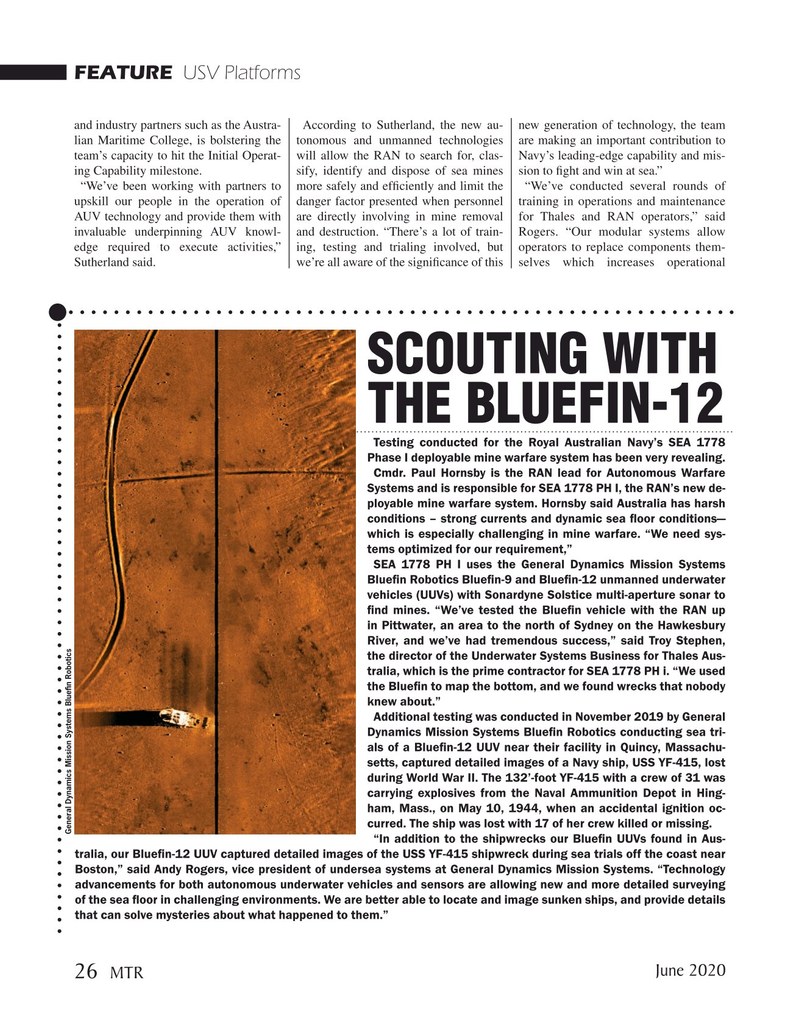
Page 26: of Marine Technology Magazine (June 2020)
Read this page in Pdf, Flash or Html5 edition of June 2020 Marine Technology Magazine
FEATURE USV Platforms and industry partners such as the Austra- According to Sutherland, the new au- new generation of technology, the team lian Maritime College, is bolstering the tonomous and unmanned technologies are making an important contribution to team’s capacity to hit the Initial Operat- will allow the RAN to search for, clas- Navy’s leading-edge capability and mis- ing Capability milestone. sify, identify and dispose of sea mines sion to fght and win at sea.” “We’ve been working with partners to more safely and effciently and limit the “We’ve conducted several rounds of upskill our people in the operation of danger factor presented when personnel training in operations and maintenance
AUV technology and provide them with are directly involving in mine removal for Thales and RAN operators,” said invaluable underpinning AUV knowl- and destruction. “There’s a lot of train- Rogers. “Our modular systems allow edge required to execute activities,” ing, testing and trialing involved, but operators to replace components them-
Sutherland said. we’re all aware of the signifcance of this selves which increases operational
Scouting with the Bluefin-12
Testing conducted for the Royal Australian Navy’s SEA 1778
Phase I deployable mine warfare system has been very revealing.
Cmdr. Paul Hornsby is the RAN lead for Autonomous Warfare
Systems and is responsible for SEA 1778 PH I, the RAN’s new de- ployable mine warfare system. Hornsby said Australia has harsh conditions – strong currents and dynamic sea foor conditions— which is especially challenging in mine warfare. “We need sys- tems optimized for our requirement,”
SEA 1778 PH I uses the General Dynamics Mission Systems
Bluefn Robotics Bluefn-9 and Bluefn-12 unmanned underwater vehicles (UUVs) with Sonardyne Solstice multi-aperture sonar to fnd mines. “We’ve tested the Bluefn vehicle with the RAN up in Pittwater, an area to the north of Sydney on the Hawkesbury
River, and we’ve had tremendous success,” said Troy Stephen, the director of the Underwater Systems Business for Thales Aus- tralia, which is the prime contractor for SEA 1778 PH i. “We used the Bluefn to map the bottom, and we found wrecks that nobody knew about.”
Additional testing was conducted in November 2019 by General
Dynamics Mission Systems Bluefn Robotics conducting sea tri- als of a Bluefn-12 UUV near their facility in Quincy, Massachu- setts, captured detailed images of a Navy ship, USS YF-415, lost during World War II. The 132’-foot YF-415 with a crew of 31 was carrying explosives from the Naval Ammunition Depot in Hing- ham, Mass., on May 10, 1944, when an accidental ignition oc- curred. The ship was lost with 17 of her crew killed or missing.
General Dynamics Mission Systems Bluefn Robotics “In addition to the shipwrecks our Bluefn UUVs found in Aus- tralia, our Bluefn-12 UUV captured detailed images of the USS YF-415 shipwreck during sea trials off the coast near
Boston,” said Andy Rogers, vice president of undersea systems at General Dynamics Mission Systems. “Technology advancements for both autonomous underwater vehicles and sensors are allowing new and more detailed surveying of the sea foor in challenging environments. We are better able to locate and image sunken ships, and provide details that can solve mysteries about what happened to them.” June 2020 26
MTR

 25
25

 27
27
